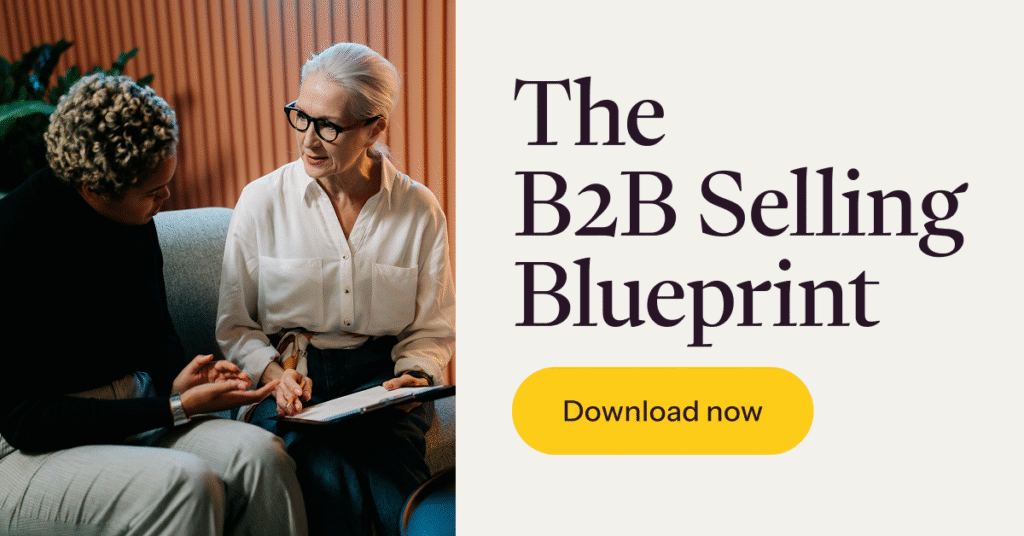If you’re reading this article, I assume you’ve built a successful online education business, selling learning products like online courses, eBooks, and guides, directly to individual consumers. But now, you’re wondering: “How do I take what I’ve built and unlock the next level of growth?”
If this is you, you’re not alone. For many online educators and market leaders, growth in the B2C space eventually hits a ceiling. The good news is that there’s a way forward: selling to businesses.
In fact, at a point, selling to businesses—or making the “B2B leap”—becomes not just a smart option, but a necessary move to keep scaling. Transitioning from B2C to B2B means selling in bulk, landing higher-value deals, and creating long-term partnerships.
It might feel like a big shift. But remember: whether you’re selling to one person or a hundred, it all comes down to one thing: person-to-person connection.
In this blog post, we’ll walk you through:
- What the Knowledge Commerce Customer Lifecycle is, and how it helps you identify where you are in your B2B selling journey
- The difference between B2C and B2B
- 10 actionable steps to help you get started selling to businesses
- How Thinkific Plus helps you make the B2B leap
Related: Learn how to plan, position, launch, and grow your B2B offering with this free, on-demand series.
Where are you on the Knowledge Commerce Customer Lifecycle?
Before diving into the how-to, it’s helpful to understand the growth journey many online educators and course experts follow. It often begins with a single course and evolves into large-scale B2B deals with organizations around the world.
We call this journey ‘the Knowledge Commerce Customer Lifecycle Blueprint’ (a mouthful, I know), and here’s what it often looks like:
- Start in B2C: Many educators begin by selling directly to individual learners. They build a personal brand, grow their audience through content and community, and start generating consistent income from course sales on their own.
- Spot group-buying opportunities: As their reach expands, some begin to notice patterns—small groups purchasing access together, or inquiries from teams and communities interested in bulk access. This stage often sees them realize that their content can serve not just individuals, but entire organizations.
- Shift to B2B: With that realization, they take the first step into B2B by packaging their courses for teams. This may involve creating business-facing offers, adjusting pricing models, and developing content bundles that align with organizational learning goals.
- Level up their tech: As they enter the B2B space, these educators often start using more advanced features within Thinkific or their chosen LMS, such as multiple site admins, cohort management, live session capabilities, and deeper customization options to match the needs of their new clients.
- Seek dedicated support: Selling to businesses introduces more complexity, from client onboarding to learner progress tracking. As they grow, many educators find that standard support channels aren’t enough, and opt for a dedicated Customer Success Manager (such as the ones offered through Thinkific Plus) who understands their specific business model and can offer personalized support.
- Land enterprise clients: Eventually, some course experts move beyond small businesses and begin working with enterprise organizations. At this level, they’re not just selling courses; they’re licensing learning experiences. They may need to scale delivery across departments or regions, meet strict procurement requirements, and provide custom solutions for each client.
Now, selling thousands of seats in one fell swoop sounds fantastic, but it comes with its own set of challenges and differences. Let’s take a look at them below. . But Thinkific Plus is built to handle this exact kind of growth.
For example, when businesses need extra control, like dividing learners into private cohorts or maintaining separate branding, we’ve seen educators spin up independent Thinkific sites (or “instances”) for each of their larger clients. This way, they can provide immersive, white-labeled learning experiences to big clients.
The thing with making the B2B leap is that it can be a daunting process if you don’t have the right tools. That’s why we built a fully integrated B2B selling suite inside Thinkific Plus. This suite is designed to help experts like you scale into B2B without reinventing your business or drowning in admin tasks.
Whether you’re just starting to explore bulk selling or you’re ready to land enterprise clients, we’ve got the infrastructure and the support to get you there.
B2C vs. B2B selling: What’s the difference?
Making the shift from B2C to B2B selling requires a fundamental shift in how online educators think about their audience, their content, and their operations. Here’s a tabular breakdown of how B2C and B2B differ across key areas, from how you market your courses to how you deliver them.
| B2C (Business-to-Consumer) selling | B2B (Business-to-Business) selling | |
| Target audience | The audience is made up of individual learners who are personally motivated to develop new skills or gain knowledge. Purchases are often self-funded. | The audience includes companies, teams, or departments looking to upskill their staff. Decision-makers are often HR leaders, team managers, or department heads, not the end learners themselves. |
| Sales cycle | The sales cycle is typically short. Individuals often make purchasing decisions within minutes to days, based on their personal goals or interests. | The sales cycle is longer and more complex. It involves multiple stakeholders and can take weeks or months due to approval processes, budget reviews, and internal discussions. |
| Buying motivation | Purchases are driven by personal growth, curiosity, or immediate needs. Emotions often play a big role in decision-making. | ROI, team performance, compliance requirements, or business outcomes drive buying decisions. Purchases are often strategic and tied to KPIs. |
| Course content | Course content is often more general, self-paced, and built for solo consumption. It may include evergreen videos, quizzes, and downloadable materials. | Content may be more structured around business objectives, learning paths, and group activities. It often includes live sessions, instructor support, team-based tracking, and progress reporting. |
| Customization needs | Learners use the content as-is. There is limited need for customization or platform branding. | Businesses often request custom branding, reporting dashboards, cohort-based tracking, and tailored onboarding experiences to align with company goals. |
| User management | A single user signs up and learns independently. There’s minimal need for user management features. | Companies often need to manage large groups of learners. Admin roles, group enrollments, and visibility into progress are essential features. |
| Support expectations | Most learners rely on self-serve support like FAQs or community forums. | Business clients expect high-touch support, onboarding guidance, and a dedicated success manager to ensure their teams are successful. |
| Pricing structure | Pricing is usually flat or tiered and designed for individuals. | Pricing is often volume-based and negotiated per contract, especially for large teams or enterprise clients. |
| Marketing approach | Marketing focuses on emotional connection, direct response, and clear personal outcomes. Social proof and testimonials from other learners are powerful tools. | Marketing focuses on demonstrating business value, efficiency, and impact. Case studies, ROI calculators, and performance data resonate more with business buyers. |
Read: B2C vs B2B Sales: Key Differences
10 steps to taking the B2B leap
Ok, so you’ve identified that you are ready to diversify and shift your audience, but where do you begin?
Here are 10 steps to help get you started:
1. Capitalize on organic demand.
One of the easiest places to start when exploring B2B selling is capitalizing on the audience that might already exist for you. Maybe there are already businesses looking to buy your courses in bulk, but simply can’t because it hasn’t been set up.
Why not set up a bulk purchase option on your site and see who buys more than one seat? You might be surprised to find that organic demand already exists.
Pro tip: Audit your current student list and see if there are multiple emails with the same domain name. This could indicate that a company has purchased more than one seat for its employees.
2. Get to know your ICP (Ideal Customer Profile).
It’s time to do some exploration on your ideal customer by crafting your B2B “Ideal Customer Profile”. Here are some questions that can help you get started:
- Who are your buyers, and students?
- What is their demographic?
- What industry do they work in?
- What kind of learning offerings, or training are they interested in?
- How do they access information?
- Audit your current student base: Do you have multiple students from the same employer?
Dig a bit deeper by conducting qualitative research. Set up interviews with your happiest students and ask questions to understand what motivated them to purchase your course, what keeps them engaged in the learning process, and learn how they heard about you.
Ask them if they can introduce you to their Learning and Development or HR department for further research.
Based on your findings, create a profile of your ideal student and where they work. This will help you identify who your B2B target audience is.
3. Talk to your audience.
Now that you’ve identified who your ideal student is, connect with relevant employees at those businesses to understand how you can effectively position your courses and provide value.
Ask questions like:
- Do you need to alter your content in some way?
- How do they access the course?
- Do they offer online courses to their students?
- What is the value proposition that would resonate most?
Pro tip: Offer complimentary course access to gain traction in return for a case study or a discount on future courses.
4. Position your B2B brand offering.
Now that you have an understanding of your target companies and how you can provide value to them, create your B2B offering and position it using what you’ve learned in step 3.
Start by reframing your messaging. Instead of focusing on what individuals will learn, highlight what the business will gain, e.g., reduced onboarding time, better compliance, increased team productivity, etc. Use language that speaks to decision-makers like HR leads, team managers, and department heads.
Then, create a dedicated landing page that speaks directly to this audience. Make sure it includes:
- A clear headline that addresses the business problem you solve
- A breakdown of how your course fits into their workflow or goals
- An overview of features businesses care about, like group access, cohort management, analytics, and branding options
- Case studies or testimonials from past clients to show proven success
- A strong call to action that invites them to book a demo, get in touch, or request a quote
Pro tip: If you have data on learner progress, completion rates, or business outcomes, include it. Numbers speak volumes in B2B conversations and can set your offer apart.
5. Develop your B2B pricing strategy.
Pricing for businesses is very different from pricing for individual learners. It’s less about what a single user can afford and more about how your offer fits into a company’s budget, goals, and procurement process.
Start by thinking in terms of value, not volume. Focus on how your training saves time, boosts performance, or streamlines onboarding. When the perceived value is high, businesses are more willing to invest.
Here are a few pricing strategies to consider:
- Volume-based pricing: Offer tiered pricing based on the number of seats or teams enrolled. This gives companies an incentive to buy more upfront for a lower per-seat cost.
- Bundled course packages: Group together multiple courses that serve a shared learning goal, like onboarding, upskilling, or leadership development, and sell them as a tailored bundle for specific roles or industries.
- Licensing model: For larger organizations, a licensing fee for unlimited or time-bound access can offer simplicity and predictability. This works well when companies want flexibility to enroll learners at scale.
- Membership or subscription: If you have a growing content library or ongoing live sessions, consider offering a recurring membership for companies. This creates recurring revenue and keeps clients engaged long-term.
- Custom packages: Offer bespoke pricing for enterprise clients who need branded instances, dedicated support, or specialized integrations. Flexibility can open the door to much larger deals.
Also, think about incentives. Can you offer a discount for annual billing? A bonus course for bulk purchases? Or early access to new content for committed partners?
Learn more: Discover how to tier pricing for B2B course sales with the Bulk Sell App
6. Generate demand.
Kickstart B2B sales by turning individual learners into advocates. If your course has helped someone perform better at work, there’s a strong chance their manager or HR team would want others to benefit too. Ask your happiest customers if they’d be open to introducing you to their employer.
From there, start mapping out a list of businesses that could benefit from your content. Look at your existing customer data—where do they work? What industries are showing consistent interest?
Once you’ve identified potential fits, begin outreach with clear, value-driven messaging. Focus on what your courses help teams do better: onboarding faster, closing skill gaps, or improving retention. If you’re feeling bold, reach out to some LinkedIn contacts at businesses you think would be a good fit, and show them exactly how their teams could benefit.
Pro tip: Be sure to differentiate your paying customer (B2B target audience) vs. your end-user (your students). How you market to your paying customer will likely be different than how you reach your end-user.
7. Ask for feedback and deliver on customer success.
As you start to generate B2B sales, now is the time to start providing an incredible customer experience.
Ask for feedback consistently. Survey your B2B customers to determine if they are getting value from the course and if there are ways you can improve the overall experience, both for the client and the student.
Then use this information to iterate on your course design and business operations. If there is a common theme or issue, can you remedy it, publish a helpful article, or troubleshoot to reduce this issue?
Read: Customer Engagement Marketing: Strategies to Drive Customer Loyalty and Business Growth
8. Deepen customer relationships.
Winning the first deal is just the beginning. Once a business has a good experience with your course, there’s a natural opportunity to deepen the relationship.
Start by keeping the lines of communication open. Ask your B2B customers what other topics their teams are struggling with, what content gaps they see, and where your training could go next. Their feedback can directly shape your next course or bundle.
From there, offer incentives that make it easy for them to expand, like discounts on additional seat purchases, early access to new content, or bundled pricing for ongoing learning.
Retention matters just as much as acquisition. The more value you deliver, the easier it becomes to grow your footprint inside an organization, from one department to several, or from one team to an entire company.
9. Start your enterprise expansion.
Once you’ve built a base of satisfied B2B customers, the next step is moving upmarket. If smaller companies consistently buy in bulk, larger organizations could benefit from your content too, at a much bigger scale.
Look at your best customers and use their success as proof. Turn their stories into case studies and testimonials that speak to business results. These become powerful assets when approaching enterprise prospects.
As you engage with larger companies, focus on the experience. Many enterprise clients expect a polished, fully branded learning environment. With platforms like Thinkific Plus, you can offer white-labeled course sites tailored to each client, making it easy for them to deliver your training at scale, with their own branding and structure.
10. Keep testing!
The B2B market isn’t static, and neither are your customers. Their needs shift, goals change, and expectations rise. The most successful educators treat their B2B offering as a living product, not a one-and-done launch.
So, keep testing your content, messaging, delivery model, and pricing. Track what’s working, listen to client feedback, and adapt quickly. Whether it’s updating course material, rolling out new features, or refining onboarding flows, small changes can drive big results over time.
To do this well, you need a platform that’s built for agility. Thinkific Plus is designed to help you make continuous improvements without starting from scratch, so your business can evolve as fast as your clients do.
How Thinkific Plus helps you make the B2B leap
Thinkific Plus offers a B2B selling suite built to support the real-world needs of educators selling to businesses.
Here’s how Thinkific Plus gives you the systems, flexibility, and scale to grow your business from one-off sales to enterprise deals:
1. Product bundles
Package multiple learning products, like courses, communities, and digital resources, into a single, customized offer for business clients by creating a product bundle. This gives you room to increase deal value while giving companies a more complete training solution.
For example, you could:
- Combine several courses and a private discussion space into one cohesive team training program
- Design a step-by-step learning path that moves employees from beginner to advanced
- Add digital resources like templates, guides, or checklists to support your content
- Turn lower-priced B2C products into a premium B2B bundle with more value and higher margins
Bundling lets you serve bigger needs and charge accordingly.
2. Groups
When working with multiple businesses, things can get messy fast. Thinkific’s Groups feature keeps everything organized by letting you segment learners by company, department, or cohort.
You can:
- Assign learners to specific businesses or teams
- Customize pricing and content per group
- Track each group’s progress and generate reports
- Give client admins access to manage and monitor their own learners
- Run bulk actions like enrolling or importing whole teams at once
This makes it easy to scale without chaos, while giving each client a personalized experience.
3. Group orders
Selling training to teams used to mean spreadsheets, email threads, and lots of manual work. Thinkific Plus simplifies it with Group Orders, a feature that lets businesses purchase multiple course seats in one smooth checkout.
Here’s how it works:
- A business buys as many seats as they need, all in one go
- They get a dashboard to assign seats to their team directly
- They can come back later and add more seats anytime
On your side, it saves you and your team hours of admin and lets you set pricing tiers or upsells to grow average deal size.
4. Custom branding
B2B clients want the learning experience to feel like an extension of their own brand. With Thinkific Plus, you can customize everything from the course dashboard to course player to reflect a client’s visual identity.
If a client needs a fully white-labeled solution, you can even create a dedicated Thinkific site with a custom domain just for them. The content stays the same, but the experience feels completely theirs.
This level of branding not only adds polish, but it positions you as a high-end, flexible provider that understands how businesses want to be represented.
5. Invoicing
Many companies, especially larger ones, prefer to pay by invoice instead of card. Thinkific’sOur Invoicing feature makes it easy for you to generate branded invoices right from your dashboard and automate access once payment is received.
You can:
- Send polished, professional invoices tailored to each deal
- Offer a more formal buying process that meets procurement requirements
- Automatically grant course access once payment clears
- Keep your sales and payment records neatly in one place
This removes friction for corporate buyers and adds a layer of trust and professionalism to your sales process.
Whether you’re selling 10 seats or 10,000, Thinkific Plus is built to support your growth. From streamlining your operations to increasing your revenue per sale, these tools are here to help you deliver a world-class experience, without getting buried in admin.
Start Your B2B Journey Today With The B2B Selling Blueprint

Download our free guide with practical steps, automation tips, and the foundational framework you need to confidently launch or scale your B2B learning program—without adding operational complexity.






